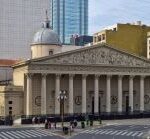May 17, 2014
It’s chilly in Chile, where we landed two hours ago, a country nestled between the Andes (crossing at night was not too exciting) and the Pacific. And it is chilly here–around 10 degrees Celsius for a high, and dry; our guide said average rainfall is 8 inches, and a desert in the north is supposedly the driest place on earth.
One of my readers (David) corrected my history of the tango, which is from the Belle Epoque period–before world war I, which was the height of affluence in Argentina, and the joy of much of our tour of the city today. The Plaza du Mayo, which is where the Cathedral is located, also housed the royal governor’s quarters and the Pink Palace that at one time, I believe, was the Parliament building. The square is the major scene for protests, including, Saturday morning, the veterans of the Falklands (Malvinas) campaign 30 years ago. The stunning cathedral, built in classical style (you can hardly be the Paris of South America without aping Paris), and looking like the Parthenon from the outside, also houses the body of Jose San Martin, the liberator who in the Plaza sounded the call to revolution from the French on May 25, 1810. From what I understand, while he drove the Spanish out of Argentina, Chile and Peru (that’s the Argentine version), victory was followed by civil war in Argentina (the 3 Spanish viceroys eventually divided into 8 countries) which lasted until the 1850s, when I believe San Martin’s body was brought back from Paris. The tomb rather resembles Napoleon’s. Not having participated in two world wars which altered the face of Europe and Asian pretenders to be Paris (e.g., Saigon and Shanghai), much of the Belle Epoque remains intact, which makes the wide boulevards and statues appropriately majestic for a capital city. I think I took more pictures today than in the previous week combined.
built in classical style (you can hardly be the Paris of South America without aping Paris), and looking like the Parthenon from the outside, also houses the body of Jose San Martin, the liberator who in the Plaza sounded the call to revolution from the French on May 25, 1810. From what I understand, while he drove the Spanish out of Argentina, Chile and Peru (that’s the Argentine version), victory was followed by civil war in Argentina (the 3 Spanish viceroys eventually divided into 8 countries) which lasted until the 1850s, when I believe San Martin’s body was brought back from Paris. The tomb rather resembles Napoleon’s. Not having participated in two world wars which altered the face of Europe and Asian pretenders to be Paris (e.g., Saigon and Shanghai), much of the Belle Epoque remains intact, which makes the wide boulevards and statues appropriately majestic for a capital city. I think I took more pictures today than in the previous week combined.
We also went to one of the harbors, the Boca neighborhood, where the former rundown Italian area has been gentrified, painted with bright colors, and turned into a boutique/craftsy art area, with handicrafts and local goods such as Havanna, a wonderful chocolate rich with caramel.
The third area was Recoleta, another Belle Epoque resting place–so to speak; it’s a cemetery whose mausoleums are way over the top, housing the remains of politicians, lawyers, doctors, and Evita, who is buried with her  brother in an elaborate tomb that is the destination for most tourist traffic. Eva Peron–who died I believe in 1952–still exercises a magnetic charm in Argentine politics. The cemetery is the equivalent of the one in Paris that has the remains of Jim Morrison of the Doors–there’s that Paris connection again– built when Argentina was one of the 10 richest countries in the world.
brother in an elaborate tomb that is the destination for most tourist traffic. Eva Peron–who died I believe in 1952–still exercises a magnetic charm in Argentine politics. The cemetery is the equivalent of the one in Paris that has the remains of Jim Morrison of the Doors–there’s that Paris connection again– built when Argentina was one of the 10 richest countries in the world.
We had a great lesson in doing international business when we landed at the airport in Chile. One of our faculty was pulled aside and informed that there was a banana in his carry on, and fruits and vegetables were strictly forbidden entry in the country. Since the faculty member (“Not me”) had mistakenly checked the customs box that he was not importing anything, he spent ½ hour in a special room apologizing profusely, signing documents that would surface should he ever do the same again, saved primarily by the Florida International assistant who was Spanish speaking. A great lesson, as I tell my students, on the hazards of doing international business.
I’m just glad it was “not me”.
Tomorrow we get to sample the Andes, and I’m really looking forward to it.